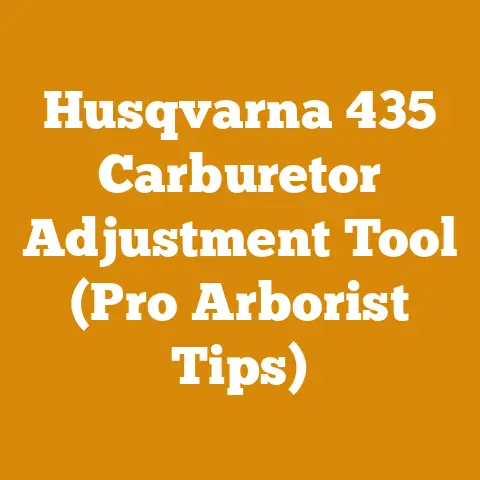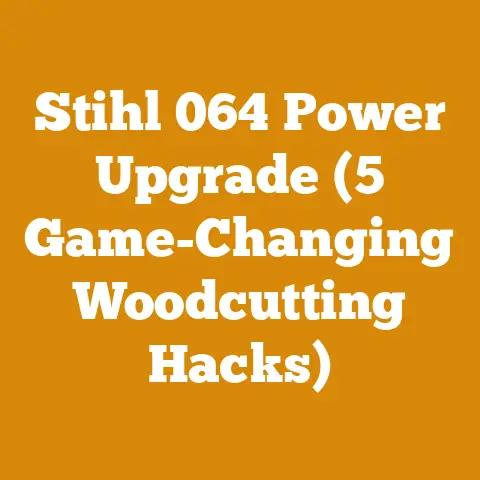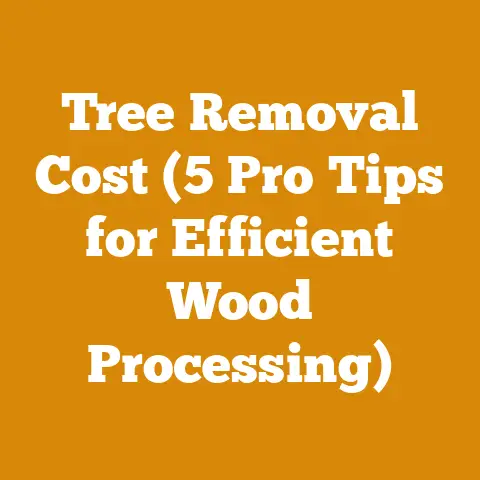How Hot Can a Wood Fire Get? (5 Heat Factors You Must Know)
Harnessing the heat of a wood fire efficiently is not just about cozying up on a cold evening; it’s about maximizing your energy savings. Understanding how hot a wood fire can get, and the factors influencing that heat, is crucial for anyone relying on wood for heating, cooking, or even for industrial processes. The hotter and more efficiently your fire burns, the less wood you’ll need, and the more cost-effective your operation will be. So, let’s dive into the fiery heart of the matter.
How Hot Can a Wood Fire Get? (5 Heat Factors You Must Know)
Wood fires aren’t a one-size-fits-all affair. The temperature can vary widely, influenced by a multitude of factors. Typically, a well-established wood fire can range from 1,000°F (538°C) to 2,000°F (1,093°C), and in some industrial settings, even higher. But what determines where your fire falls within this range? Let’s explore the five key factors that dictate the heat of your wood fire.
1. The Type of Wood: Fueling the Flames
The type of wood you burn is arguably the most significant factor determining the heat output. Different wood species have different densities and resin content, which directly impact their BTU (British Thermal Unit) value – a measure of heat content.
-
Hardwoods vs. Softwoods: Hardwoods, like oak, maple, and ash, are denser than softwoods like pine, fir, and cedar. This density translates to more fuel per unit volume, resulting in a hotter and longer-lasting fire.
-
BTU Value: The BTU value of wood is measured per cord (a stacked volume of 128 cubic feet). For example, a cord of seasoned oak might have a BTU value of around 24-30 million, while a cord of pine might have only 15-20 million.
-
Resin Content: Softwoods often contain higher levels of resin, which makes them easier to ignite but also causes them to burn faster and produce more smoke. While this resin can create a quick, intense burst of heat, it’s not ideal for sustained high temperatures.
My Experience: I remember one winter when I was short on seasoned oak and had to rely on a mix of pine and birch. The pine ignited quickly, but I was constantly feeding the fire to maintain a consistent temperature. The oak, on the other hand, burned steadily for hours with minimal intervention. It was a clear demonstration of the difference in heat output between hardwoods and softwoods.
Cost Considerations: Wood Species Impact
The type of wood you choose not only affects the heat output but also your wallet. Here’s a glimpse into the cost implications:
-
Hardwood Prices: Hardwoods generally command a higher price per cord compared to softwoods. This is due to their higher BTU value and longer burn time. In my region (Pacific Northwest, USA), a cord of seasoned oak can cost anywhere from $350 to $500, while a cord of pine might range from $200 to $300. These prices can fluctuate based on local supply and demand, transportation costs, and the time of year.
-
Softwood Prices: Softwoods, while cheaper, require more frequent replenishment, potentially offsetting the initial cost savings. Consider the total heating needs and the efficiency of your wood-burning appliance when making your decision.
-
Mixed Loads: Some suppliers offer mixed loads of hardwoods and softwoods, which can be a cost-effective option if you’re looking for a balance between quick ignition and sustained heat. I often opt for a mix of birch (easy to ignite) and maple (long-lasting heat) for my wood-burning stove.
Data Point: According to the U.S. Energy Information Administration (EIA), the average price for a cord of firewood in the United States varies significantly by region, ranging from $200 to $600, depending on the species and local availability.
Budgeting for Wood Type: A Practical Approach
When budgeting for your wood-burning needs, consider the following:
-
Estimate Your Heating Needs: Calculate the amount of wood you’ll need based on your climate, the size of your home, and the efficiency of your wood-burning appliance.
-
Compare Prices: Obtain quotes from multiple suppliers for different wood species. Factor in delivery costs and any stacking fees.
-
Consider Seasoning: Seasoned wood is crucial for efficient burning. If you’re buying green wood, factor in the cost of storing and seasoning it yourself.
-
Evaluate Long-Term Costs: While softwoods may seem cheaper upfront, they may require more frequent replenishment, potentially increasing your overall costs.
Example Calculation:
Let’s say you need 4 cords of wood to heat your home for the winter.
- Option 1: Hardwood (Oak) at $400 per cord: Total cost = 4 x $400 = $1600
- Option 2: Softwood (Pine) at $250 per cord: Total cost = 4 x $250 = $1000
However, if you estimate that you’ll need to burn twice as much pine to achieve the same heat output as oak, the cost of pine would be $2000 (8 cords x $250).
Actionable Tip: Invest in a moisture meter to ensure that your wood is properly seasoned before burning. This will improve its efficiency and reduce smoke emissions.
2. Moisture Content: The Enemy of Heat
Moisture content is a critical factor affecting the heat output of your wood fire. Wet or green wood contains a significant amount of water, which must be evaporated before the wood can burn efficiently. This process consumes energy, reducing the overall heat output and creating more smoke.
-
Seasoning: Seasoning is the process of drying wood to reduce its moisture content. Ideally, firewood should be seasoned for at least six months to a year, depending on the climate and wood species.
-
Optimal Moisture Content: The ideal moisture content for firewood is between 15% and 20%. Wood with moisture content above 20% will be difficult to ignite, produce less heat, and create more creosote buildup in your chimney.
-
Testing Moisture Content: You can use a moisture meter to accurately measure the moisture content of your firewood. Simply insert the probes into a freshly split piece of wood and read the display.
My Experience: I once made the mistake of burning wood that I thought was seasoned, but it turned out to have a moisture content of around 30%. The fire was sluggish, produced a lot of smoke, and left a sticky residue in my chimney. I learned my lesson the hard way – always check the moisture content before burning!
Cost Implications of Moisture Content
Burning wet wood can have significant cost implications:
- Reduced Heat Output: Wet wood burns less efficiently, meaning you’ll need to burn more wood to achieve the same level of heat. This translates to higher wood consumption and increased fuel costs.
- Increased Creosote Buildup: Burning wet wood produces more creosote, a flammable substance that can accumulate in your chimney and increase the risk of a chimney fire. Regular chimney cleaning is essential to prevent this, which adds to your maintenance costs.
- Appliance Damage: Burning wet wood can also damage your wood-burning appliance over time. The corrosive compounds in the smoke can corrode metal components and reduce the lifespan of your stove or fireplace.
Data Point: According to the Chimney Safety Institute of America (CSIA), chimney fires cause an estimated $200 million in property damage each year in the United States alone. Burning wet wood is a major contributing factor to these fires.
Budgeting for Seasoning and Moisture Control
To minimize the cost implications of moisture content, consider the following:
-
Buy Seasoned Wood: If possible, purchase seasoned wood from a reputable supplier. Ask for a guarantee on the moisture content.
-
Season Your Own Wood: If you’re buying green wood, invest in proper storage and seasoning techniques. Stack the wood in a sunny, well-ventilated area, and cover the top to protect it from rain and snow.
-
Invest in a Moisture Meter: A moisture meter is a relatively inexpensive tool that can save you money and hassle in the long run.
-
Factor in Chimney Cleaning Costs: Regular chimney cleaning is essential, especially if you’re burning wood frequently. Budget for this expense in your annual heating costs.
Example Calculation:
Let’s say you need 3 cords of seasoned wood to heat your home for the winter.
- Option 1: Buy seasoned wood at $400 per cord: Total cost = 3 x $400 = $1200
- Option 2: Buy green wood at $250 per cord: Total cost = 3 x $250 = $750
However, if you estimate that you’ll need to burn 50% more green wood to achieve the same heat output as seasoned wood, the cost of green wood would be $1125 (4.5 cords x $250). Additionally, you’ll need to factor in the cost of storing and seasoning the wood, as well as increased chimney cleaning costs.
Actionable Tip: Invest in a good quality chimney brush and learn how to clean your chimney yourself. This can save you money on professional cleaning services.
3. Airflow: The Breath of Fire
Airflow is the lifeblood of any fire. It provides the oxygen necessary for combustion, allowing the wood to burn efficiently and produce heat. Controlling airflow is essential for achieving the desired temperature and burn rate.
-
Primary Air: Primary air is the air that enters the firebox from below or through the front of the appliance. It’s crucial for igniting the wood and maintaining a steady flame.
-
Secondary Air: Secondary air is introduced into the firebox above the fire. It helps to burn off the smoke and gases produced by the wood, increasing efficiency and reducing emissions.
-
Draft: Draft is the flow of air through the chimney. A strong draft is essential for removing smoke and gases from the firebox and ensuring proper combustion.
My Experience: I once had a wood stove with a poor draft. The fire was constantly smoldering, producing a lot of smoke, and barely generating any heat. I tried everything to improve the draft – cleaning the chimney, adjusting the damper, even adding a chimney extension. Eventually, I realized that the problem was a blockage in the air intake. Once I cleared the blockage, the fire roared to life, and the stove heated my home efficiently.
Cost Implications of Airflow Management
Poor airflow can lead to several cost-related issues:
- Incomplete Combustion: Inadequate airflow results in incomplete combustion, meaning that some of the wood’s energy is wasted. This leads to higher wood consumption and increased fuel costs.
- Smoke and Emissions: Poor airflow also increases smoke and emissions, which can be harmful to your health and the environment. Some regions have regulations on wood-burning appliances and emissions, which could result in fines or restrictions.
- Appliance Damage: Incomplete combustion can also lead to creosote buildup in your chimney, increasing the risk of a chimney fire and potentially damaging your wood-burning appliance.
Data Point: According to the Environmental Protection Agency (EPA), wood-burning appliances are a significant source of air pollution, particularly in areas with high concentrations of wood-burning homes.
Budgeting for Airflow Optimization
To optimize airflow and minimize costs, consider the following:
-
Choose an Efficient Appliance: Invest in a wood-burning appliance that is designed for efficient combustion and airflow management. Look for appliances that are EPA-certified.
-
Proper Installation: Ensure that your appliance is properly installed according to the manufacturer’s instructions. This includes proper chimney sizing and placement.
-
Regular Maintenance: Regularly inspect and maintain your appliance to ensure that all air intakes and vents are clear and functioning properly.
-
Adjust Airflow Controls: Learn how to adjust the airflow controls on your appliance to achieve the desired burn rate and temperature.
Example Calculation:
Let’s say you’re considering two wood stoves:
- Stove A: EPA-certified, high-efficiency stove: Cost = $2000
- Stove B: Non-EPA-certified, low-efficiency stove: Cost = $1000
While Stove B is cheaper upfront, it may consume more wood and produce more emissions, potentially increasing your long-term costs. If you estimate that Stove A will save you 20% on wood consumption, the savings could offset the initial cost difference over time.
Actionable Tip: Install a carbon monoxide detector in your home to protect yourself from the dangers of incomplete combustion.
4. Firebox Design: Shaping the Heat
The design of the firebox plays a crucial role in determining the heat output and efficiency of a wood fire. The shape, size, and materials of the firebox can all affect how the wood burns and how the heat is distributed.
- Shape: The shape of the firebox affects airflow and combustion. A well-designed firebox will promote efficient airflow and ensure that the wood burns evenly.
- Size: The size of the firebox determines the amount of wood that can be burned at one time. A larger firebox can accommodate larger logs and longer burn times.
- Materials: The materials used to construct the firebox affect heat retention and distribution. Cast iron and steel are common materials that can withstand high temperatures and radiate heat effectively.
- Insulation: Some fireboxes are insulated to improve heat retention and reduce heat loss. Insulation can also help to maintain a more consistent temperature inside the firebox.
My Experience: I once used an open fireplace with a poorly designed firebox. The fire was difficult to control, produced a lot of smoke, and radiated very little heat into the room. I eventually replaced it with a modern wood stove with a well-designed firebox, and the difference was remarkable. The new stove burned cleaner, produced more heat, and was much easier to control.
Cost Implications of Firebox Design
An inefficient firebox design can lead to several cost-related issues:
- Reduced Heat Output: A poorly designed firebox can result in incomplete combustion and reduced heat output, leading to higher wood consumption and increased fuel costs.
- Increased Emissions: An inefficient firebox can also increase smoke and emissions, which can be harmful to your health and the environment.
- Appliance Damage: A poorly designed firebox can also lead to excessive heat stress on the appliance, potentially shortening its lifespan and increasing maintenance costs.
Data Point: According to the EPA, modern wood stoves with advanced firebox designs can be up to 70% more efficient than older, traditional stoves.
Budgeting for Firebox Optimization
To optimize your firebox and minimize costs, consider the following:
- Choose an Efficient Appliance: Invest in a wood-burning appliance with a well-designed firebox that promotes efficient combustion and heat distribution. Look for appliances that are EPA-certified.
- Proper Installation: Ensure that your appliance is properly installed according to the manufacturer’s instructions. This includes proper chimney sizing and placement.
- Firebox Accessories: Consider adding firebox accessories, such as firebacks and grates, to improve heat retention and distribution.
- Regular Maintenance: Regularly inspect and maintain your firebox to ensure that it is clean and free of obstructions.
Example Calculation:
Let’s say you’re considering two wood stoves:
- Stove A: Modern wood stove with advanced firebox design: Cost = $2500
- Stove B: Traditional wood stove with basic firebox design: Cost = $1500
While Stove B is cheaper upfront, it may consume more wood and produce more emissions, potentially increasing your long-term costs. If you estimate that Stove A will save you 30% on wood consumption, the savings could offset the initial cost difference over time.
Actionable Tip: Clean your firebox regularly to remove ash and creosote buildup. This will improve its efficiency and reduce the risk of a chimney fire.
5. Wood Arrangement: Building a Better Fire
The way you arrange the wood in the firebox can significantly impact the heat output and burn rate. Proper wood arrangement promotes efficient airflow and combustion, leading to a hotter and longer-lasting fire.
- Log Size: The size of the logs you use can affect the fire’s temperature and burn time. Smaller logs ignite quickly and produce a hotter flame, while larger logs burn longer and provide sustained heat.
- Stacking Method: The way you stack the logs in the firebox can influence airflow and combustion. Common stacking methods include the log cabin, teepee, and parallel stack.
- Kindling and Tinder: Using kindling and tinder is essential for starting a fire quickly and efficiently. Kindling consists of small, dry pieces of wood, while tinder is a highly flammable material, such as paper or cotton balls.
My Experience: I used to just throw logs haphazardly into the firebox, but I soon realized that this was not the most efficient way to build a fire. I started experimenting with different stacking methods and found that the log cabin method worked best for me. It provided good airflow and allowed the wood to burn evenly.
Cost Implications of Wood Arrangement
Improper wood arrangement can lead to several cost-related issues:
- Slow Ignition: Poor wood arrangement can make it difficult to ignite the fire, leading to wasted time and effort.
- Incomplete Combustion: Improper wood arrangement can also result in incomplete combustion, leading to higher wood consumption and increased fuel costs.
- Smoke and Emissions: Poor wood arrangement can also increase smoke and emissions, which can be harmful to your health and the environment.
Data Point: According to the Wood Heat Organization, proper wood stacking and arrangement can improve the efficiency of a wood fire by up to 20%.
Budgeting for Wood Arrangement
To optimize your wood arrangement and minimize costs, consider the following:
- Use Proper Kindling and Tinder: Invest in a good supply of kindling and tinder to start your fires quickly and efficiently.
- Experiment with Stacking Methods: Try different stacking methods to find the one that works best for your firebox and wood type.
- Adjust Log Size: Use a mix of small and large logs to achieve the desired fire temperature and burn time.
- Monitor Airflow: Pay attention to the airflow around the logs and adjust the arrangement as needed to promote efficient combustion.
Example Calculation:
Let’s say you’re using 4 cords of wood to heat your home for the winter.
- Scenario 1: Inefficient wood arrangement: Wood consumption = 4 cords
- Scenario 2: Efficient wood arrangement: Wood consumption = 3.2 cords (20% reduction)
If the cost of wood is $400 per cord, the savings from efficient wood arrangement would be $320 (0.8 cords x $400).
Actionable Tip: Learn how to build a top-down fire. This method involves placing the largest logs at the bottom of the firebox and the kindling and tinder on top. It promotes efficient combustion and reduces smoke emissions.
Conclusion: Mastering the Heat
Understanding the factors that influence the heat of a wood fire is essential for maximizing its efficiency and minimizing costs. By choosing the right type of wood, ensuring proper seasoning, optimizing airflow, selecting an efficient firebox design, and arranging the wood effectively, you can achieve a hotter and longer-lasting fire while reducing your wood consumption and environmental impact.
Remember that cost-saving in wood processing and firewood preparation is a holistic approach. It starts with understanding the energy potential of your resources and then applying best practices to maximize that potential. From selecting the right wood species to mastering the art of fire building, every step you take contributes to a more efficient and cost-effective heating solution.
So, go forth and conquer the flames! With the knowledge and strategies outlined in this article, you’ll be well-equipped to harness the heat of a wood fire efficiently and economically.






